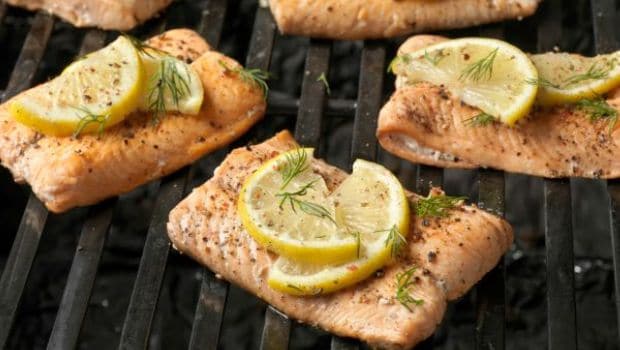The sheer joy of eating fish is known only to the lovers of seafood. Those who can’t seem to go beyond the foul smell associated with it miss out on a great expanse of culinary wonders that are delectable and oh so satisfying. The silken texture of fish when coupled with indigenous spices and local cooking techniques, renders an exquisite experience to the palate. Fish is probably one of the easiest items to cook and goes well with most ingredients. Its versatility is astonishing. Its delicate texture makes experimentation easy - it may be steamed, baked, grilled or fried to arrive at a range of lip-smacking preparations.Fish consumption has long been linked to a bevy of health benefits. Here are some of them:1) Its rich nutritional profile that comes studded with essential micronutrients including omega 3, protein, B vitamins, selenium and vitamin D among others, makes it a much sought after item among fitness enthusiasts.
2) Almost all fish and sea organisms are a rich source of vitamin E and omega 3. Regular fish consumption has long been tied to healthy hair, eyesight and skin.

3) In the year 2004, The UK Scientific Advisory Committee on Nutrition reviewed the evidence on the health benefits of fish. According to the committee, a "large body of evidence" suggests fish consumption – especially oily fish –alleviates the risk of cardiovascular diseases owing to the presence of omega-3 fatty acids in them.4) Some recent medical studies point at the association between oily fish consumption and lower blood pressure levels.5) It is also believed to reduce fat build-up in the arteries. The evidence is strong enough to warrant a government recommendation that we eat at least two portions of fish a week, one of which should be oily.Common fish types containing omega-3:- Haddock
- Salmon
- Mackerel
- Tuna"You can easily get your daily dose of omega-3 from a range of oily fish. Tinned sardines and mackerel are some of your best options, are easy to cook and light on the pocket. These can be eaten in a variety of ways - on toast, with a side salad or as a quick, easy and nutritious meal," shares Alison Hornby, a dietician and BDA spokesperson.

Although nothing can beat the crunchy goodness of fried fish, those who keep a strict watch on their calorie intake can opt for grilled, baked or steamed fish delicacies instead. Frying tends to increase the fat content of fish and shellfish, especially when they’re cooked in butter.Pregnant women are often told to avoid seafood in any form owing to the mercury content in some organisms, which can be detrimental to the development of the foetus. Carrying mothers should particularly avoid eating shark, swordfish and marlin as these types contain more mercury than other fish. However, if you are pregnant, it is recommended that you take your doctor’s word on fish consumption before giving it a try.Powered by BodyPowerDisclaimer:The opinions expressed within this article are the opinions of the author. NDTV is not responsible for the accuracy, completeness, suitability, or validity of any information on this article. All information is provided on an as-is basis. The information, facts or opinions appearing in the article do not reflect the views of NDTV and NDTV does not assume any responsibility or liability for the same.
2) Almost all fish and sea organisms are a rich source of vitamin E and omega 3. Regular fish consumption has long been tied to healthy hair, eyesight and skin.

3) In the year 2004, The UK Scientific Advisory Committee on Nutrition reviewed the evidence on the health benefits of fish. According to the committee, a "large body of evidence" suggests fish consumption – especially oily fish –alleviates the risk of cardiovascular diseases owing to the presence of omega-3 fatty acids in them.4) Some recent medical studies point at the association between oily fish consumption and lower blood pressure levels.5) It is also believed to reduce fat build-up in the arteries. The evidence is strong enough to warrant a government recommendation that we eat at least two portions of fish a week, one of which should be oily.Common fish types containing omega-3:- Haddock
- Salmon
- Mackerel
- Tuna"You can easily get your daily dose of omega-3 from a range of oily fish. Tinned sardines and mackerel are some of your best options, are easy to cook and light on the pocket. These can be eaten in a variety of ways - on toast, with a side salad or as a quick, easy and nutritious meal," shares Alison Hornby, a dietician and BDA spokesperson.

Although nothing can beat the crunchy goodness of fried fish, those who keep a strict watch on their calorie intake can opt for grilled, baked or steamed fish delicacies instead. Frying tends to increase the fat content of fish and shellfish, especially when they’re cooked in butter.Pregnant women are often told to avoid seafood in any form owing to the mercury content in some organisms, which can be detrimental to the development of the foetus. Carrying mothers should particularly avoid eating shark, swordfish and marlin as these types contain more mercury than other fish. However, if you are pregnant, it is recommended that you take your doctor’s word on fish consumption before giving it a try.Powered by BodyPowerDisclaimer:The opinions expressed within this article are the opinions of the author. NDTV is not responsible for the accuracy, completeness, suitability, or validity of any information on this article. All information is provided on an as-is basis. The information, facts or opinions appearing in the article do not reflect the views of NDTV and NDTV does not assume any responsibility or liability for the same.
Advertisement











